
Greg Windmiller: Teaching What Matters
Tuesday, June 26, 2018
- Team CYPRES
- 6/26/18
- 0
- General, Sponsored Athlete
Above photo courtesy of Daniel Angulo.
When we talk to Greg Windmiller, it’s late afternoon. He’s been up since 3 a.m., coaching night jumps for a military course. He’ll be up at 3 a.m. tomorrow, too. He coached a night jump quite recently, in fact, where the group covered 23 miles under canopy and landed in an austere environment. Just another day in the office, we suppose.
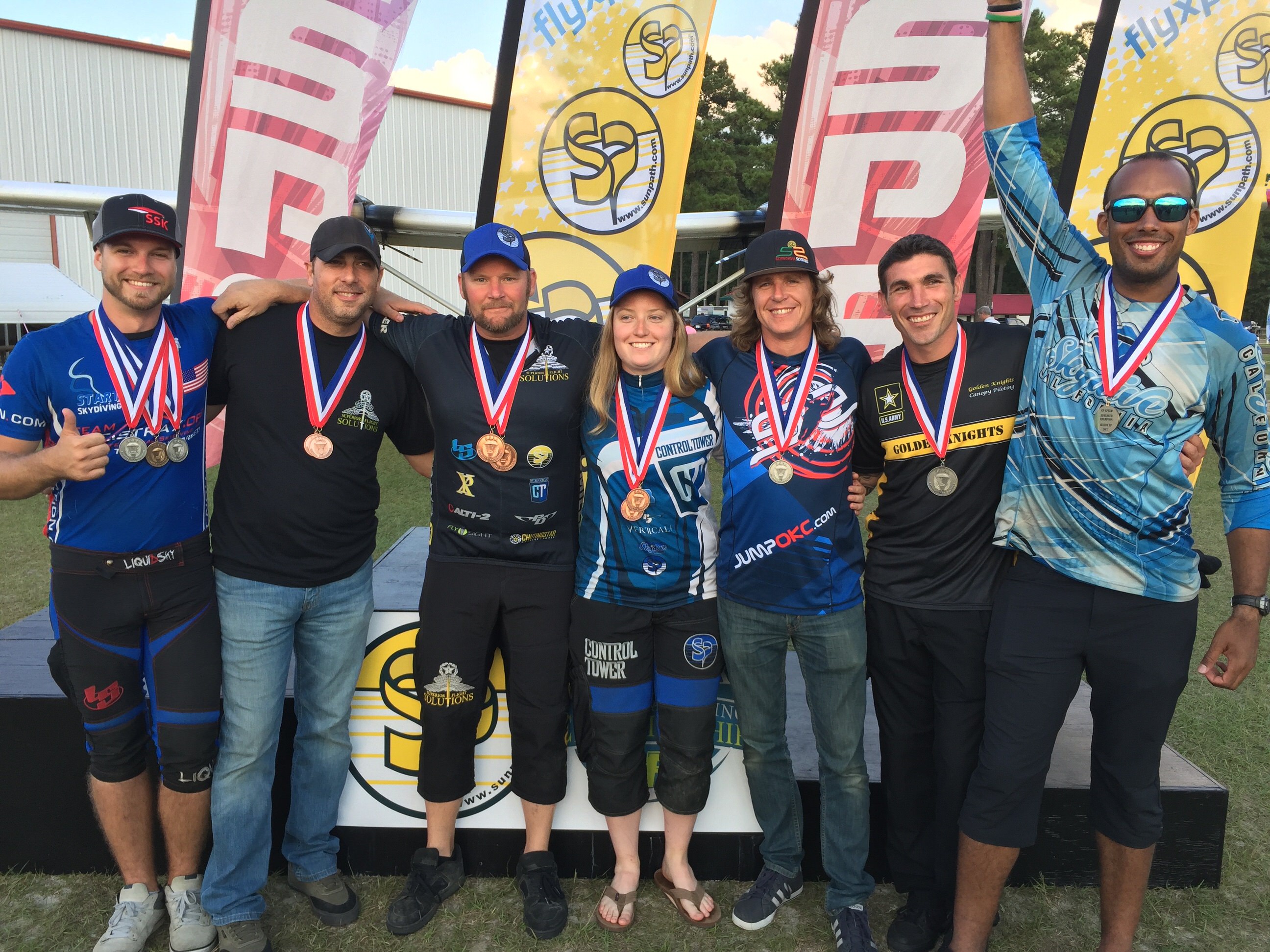
Greg, suffice it to say, has a pretty darned cool, pretty darned demanding job.
Some days, Greg has to remind himself of where he is
To do that job, he’s on the road constantly. Some days, he wakes up in a hotel room and has to check his map app to remind himself of where, exactly, he is. Today, he’s in Raeford, at the legendary Paraclete XP. The students he’s training often remind him of himself when he started skydiving: young, hungry and military.
“My first skydive was in the military,” Greg explains. “It started because I went to the Special Forces Military Freefall school. We were a special unit, and we worked in very small teams. We operated in six six-person teams. Three teams were water teams, so primary method of insertion was water. The other three teams were freefall teams, so their primary method of insertion was via parachute.”
I started out on a water team. I loved the unit so much, and I loved the job so much, that it was only after a couple of years that I realized I hated the water.
That was unfortunate, because Greg’s unit got wet a lot. They would do things like strap parachutes to boats, push them out of the back of the airplane, jump out after them with round parachutes, land in the water, put the boats into operation, and then drive the boats. Or they’d do something called over-the-horizon surface swim, where they’d swim so far out they couldn’t see the land.
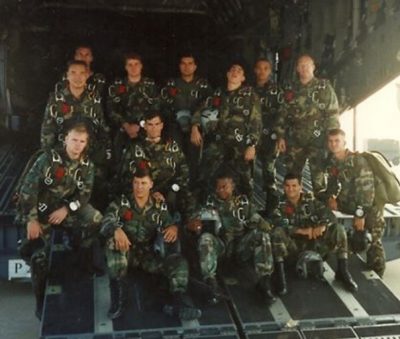
“I had so many run-ins with eels,” he laughs. “So many jellyfish stings. I actually had a run-in with a hammerhead shark that gave me a scar on my right hand. When I was getting my final physical as I retired from the military, they asked me if I had any scars. My response was, ‘Yes, this one’s from an eel; this one’s from a snake; this one’s from an alligator bite; this one’s from a hammerhead shark.’ The doctor told me I sounded like a failed Steve Irwin. I hated the water so much because I was always on the bottom of the food chain in there. I felt so out-of-my-element.”
When you feel blessed to have gotten what you asked for, but you don’t know why you asked…
To stay in the unit but out of the water, he’d have to transition to the freefall team. Problem: he didn’t love the idea of freefall, either. That said, he was willing to give it a shot. So, when the chance arose, he went to the Special Forces Military Freefall School.
“When I finally got onto the plane,” Greg muses, “I thought, ‘Okay, now I’m here. What did I get myself into?’ It was like: this is where I want to be and this is what I want to do, but strangely, I’m still not exactly sure I want to do it. I felt incredibly blessed to have gotten what I asked for, but I suddenly had no idea why I asked for this.”
His first jump was a success, albeit a hilarious success. Greg remembers that his instructor had to physically hold him up for his first jump when his knees buckled at the door.
My legs went to water, but he held me up and he kind of, like, rubbed my shoulders,
Greg laughs. “He was face to face with me, a couple inches apart, and he looked at me and he said, ‘It’s going to be okay, you can do this.’ And then he made me go. When I landed, he said, ‘I’m really glad you had fun, but next time I’m going to need you to do a little bit of what I asked you to do.’ Because I yelled and screamed the entire time. I was ecstatic. I thought it was the greatest thing ever. After that, I was hooked. I couldn’t do it enough. There wasn’t enough AV gas or enough airplanes in the world to satisfy my desire to jump.”
That passion carried him through a couple of gnarly early oopsies.
“For the first 16 jumps, I stood up every single landing. I landed where I’d wanted to; I was never unstable,” he recalls. “I didn’t have a single issue until my 17th jump.”
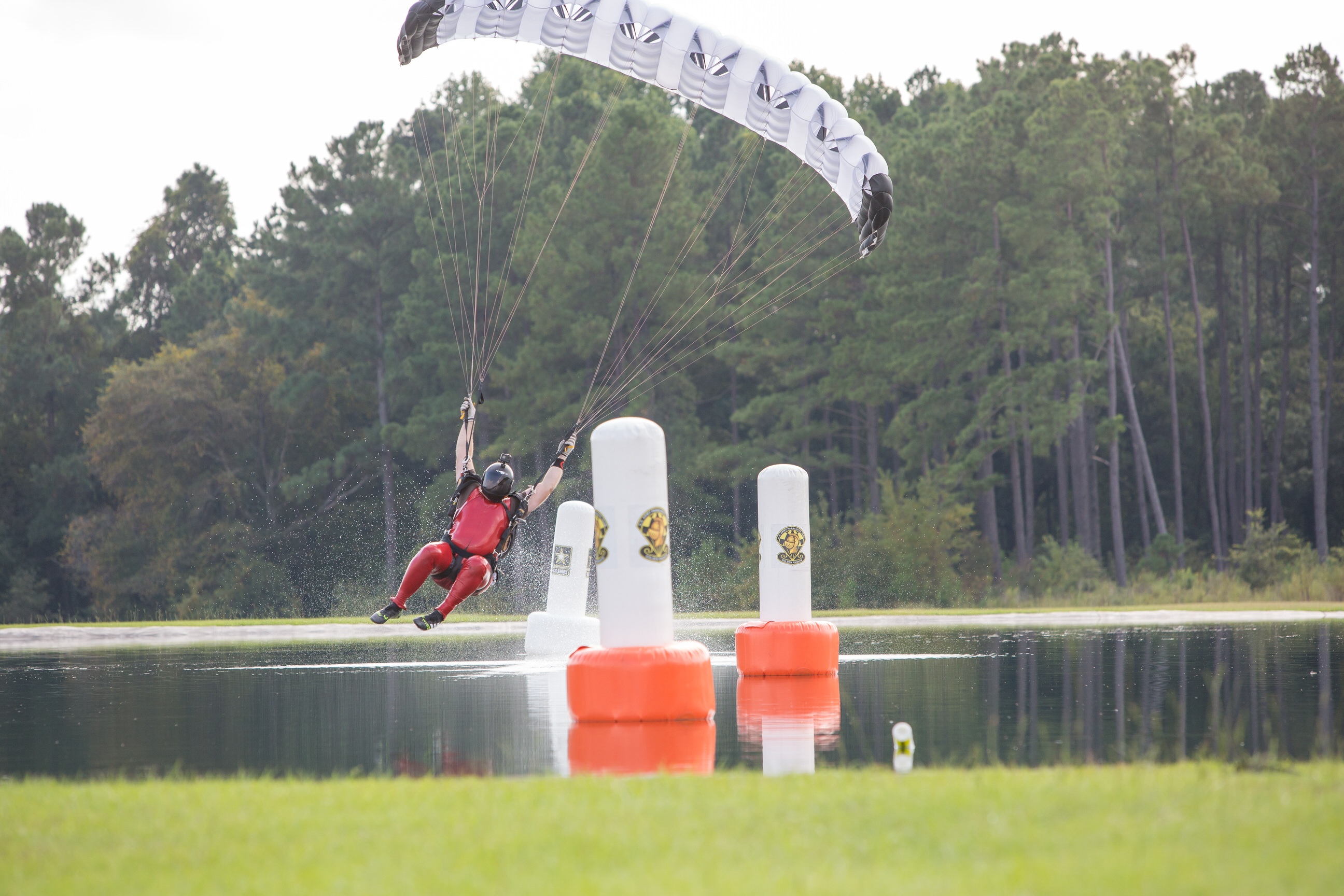
Jump no. 17: First night jump – downwind in a ditch
Jump number 17 was Greg’s first night jump. It was pitch black out, and his class didn’t jump with night vision devices. Greg ended up landing downwind in a ditch. He broke his right ankle and his left wrist — but he had two jumps to go until graduation, and a spot lined up on a HALO team after that. He could not go out with a medical. He was determined.
“They made me go to the aid station,” he remembers, “And the doctor that saw me said, ‘We’re going to have to put a cast on that for sure, and we’re probably going to have to get X-rays of this and check this out; probably get a cast for that.’ I begged him not to. I told him that, if I didn’t do the next two jumps, I was never going to come back to this course again, because this course is so hard to get into; that I was never going to get a chance to do this ever again in my career.
I told the doctor I’d wobble to the ramp and wobble off and when I come in to land I’d slide in, I wouldn’t try to stand up.”
“He was completely and totally understanding,” Greg continues. “He was a Special Forces doctor that gone through the freefall school as well. He knew my plight. So he looked at me and said, ‘All right, well, take care, and hopefully I won’t see you ever again.’”
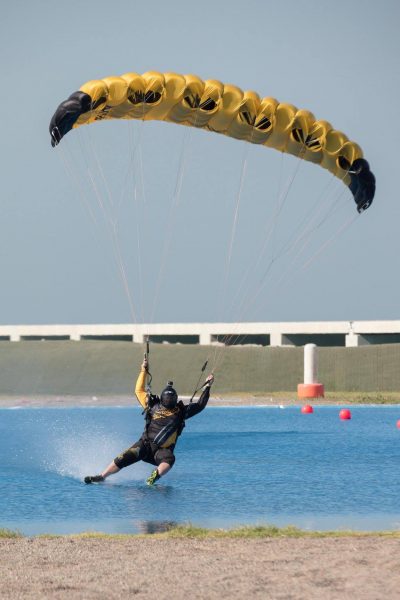
Jump no. 34: A canopy collison ended up with a breezy hole in Greg’s smile
As it turns out, that doctor didn’t see Greg again. He went to an entirely different doctor on jump number 34, when he was in a canopy collision that knocked out all his top teeth. They drove the young Sergeant from central California to Yuma, Arizona at 2a.m. to go see a military dentist. Greg was jumping the next day, albeit with a breezy hole in his smile.
I’m a little bit stubborn when it comes to pain,” Greg laughs.
‘Strong like bull, smart like tractor,’ as the saying goes.*
Greg’s sincere humility and self-deprecating sense of humor belies one heck of a resume. This “tractor,” after all, has logged 12 state records in canopy piloting speed and distance, seven national records in speed and distance, five world records in speed and six U.S. National gold medals. As a USPA US National team member (a title he has held a dozen times), Greg has captured 18 FAI world-level medals in both 4-way formation skydiving and canopy piloting, 32 USPA U.S. Nationals medals in canopy piloting, style and accuracy and sport accuracy and more than a hundred regional medals in 4-way formation skydiving, 8-way formation skydiving, style and accuracy and canopy piloting.
Selected as a Golden Knight in the year 2000, Greg co-founded the Canopy Piloting Team in 2007. Within a year of the team’s formation, Windmiller had ranked 3rd in the world that year at the World Championships, setting the first of five World Records in speed. (He entered the course at approximately 90 miles per hour.)
With bona fides like those, a career in coaching was almost a foregone conclusion.
Greg started coaching as a second job
“You don’t get paid a lot when they first start out in the army,” Greg says, “so folks tend to have second jobs like pizza delivery or working at a Lowes, or whatever. We’re allowed to have second jobs. So that’s just what I did: I started coaching as a second job.”
Let’s review, shall we? At this point, Greg is competing at the highest level for the Army, working on the Golden Knights in research and development, working with the Special Operations unit and teaching canopy control. On every single free weekend he had (when he wasn’t training or competing), he was traveling to coach.
“It got to the point where I would have between 350 and 400 students per year,” he laughs. “It was very taxing, but it was very rewarding at the same time. I just absolutely loved it. I loved the traveling. I generally set it up so I’d take the redeye out to a series of dropzones on the East Coast, because I had to work Monday through Friday in Raeford.”
All that work paid off. When Greg eventually retired after 26 years of service, it was, as he puts it, a “really smooth transition.”
These days, Greg helms the school he founded in 2010. Called Superior Flight Solutions, the school specializes in teaching, coaching and mentoring growth-minded students across several skydiving disciplines.
My favorite thing about teaching is seeing the proverbial light bulb go on,
Greg enthuses. “I think my favorite thing about teaching is, when you’re working with a group of individual students that come from so many different backgrounds and communities — so many different ways to learn — and you adjust the message so that, boom! They’re getting it. You can tell. That’s extremely rewarding.”
“I like working with the military units,” he adds, “because I did it for so long. I feel like it’s giving back.”
For Greg, that team spirit extends to the gear he jumps and the sponsor relationships he fosters. He insists that the only sponsorships he has ever entered into are sponsorships almost of coincidence — gear that he would jump no matter what support the manufacturer offered him.
“I don’t jump something because it’s given to me,” he emphasizes. “I don’t jump something because I get a good deal on it. I
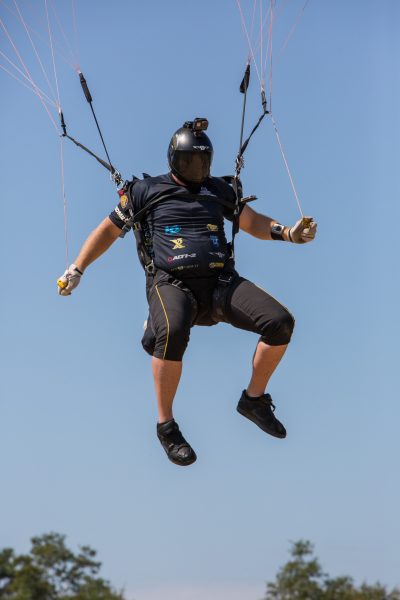
jump something because I believe in it. Because I’ve seen live saves; I’ve seen service bulletins from other manufacturers.”
Let’s talk about AAD
Automatic activation devices get Greg especially excited. We’ve been on “Team Windmiller” as long as we can remember — Greg has flown the purple flag from the start — and p art of his curriculum is a decidedly more data-minded approach to AAD awareness than most coaches offer.
“There are huge misconceptions surrounding automatic activation devices,” Greg begins. “In the last decade or so, there have been several incidents where jumpers experienced automatic activation device fires. The vast majority of them were attributable to user error.”
“But when they happen,” he continues, “The skydiving community gets in an uproar. They think, ‘Oh my gosh, this piece of equipment must be dangerous because this person with this many thousands and thousands of jumps has had this thing happen to them,’ when all it was was operator error. If you misuse a piece of equipment outside of its recommended parameters, things go wrong. I work hard to help my students understand those parameters so they can work within the safety envelope.”
To do so, Greg starts with a review of the device’s firing altitudes.
Ninety percent of skydivers don’t know at what speed the device will fire,
he says. “So I ask them. I get them thinking about it. I also ask: When does it turn on? Does it turn off? Is there a secondary activation altitude? We’ll go over all of that information so they’re knowledgeable.”
“And when I get high-performance classes and people are starting to dip their toes in flying fast parachutes,” he goes on, one of the big questions is always: how do I know if I’m getting close to firing my automatic activation device? So I’ll actually put a GPS tracking unit on them — a Flysight — and we take the data from the Flysight and compare it against the automatic activation device firing altitudes.”
The practicum includes having the student do practice turns above 2500 feet (so, if something happens, they can cut away safely). There’s another side to it, however: above 2500 feet, density altitude plays a factor. In a high-performance turn above 2500 feet, the student will tend to lose more altitude and build more speed than they would if they were doing it across the ground.
“And so when they land, I’ll show them the data,” Greg says. “I’ll say hey, this was a really good turn based on the shape, the performance and everything. And if you look here, at this altitude, you actually were approaching this speed, which is getting close to the activation altitude of this device. Before you ever do that turn close to the ground, you actually need to think about switching over to a high-speed optimized AAD unit.”
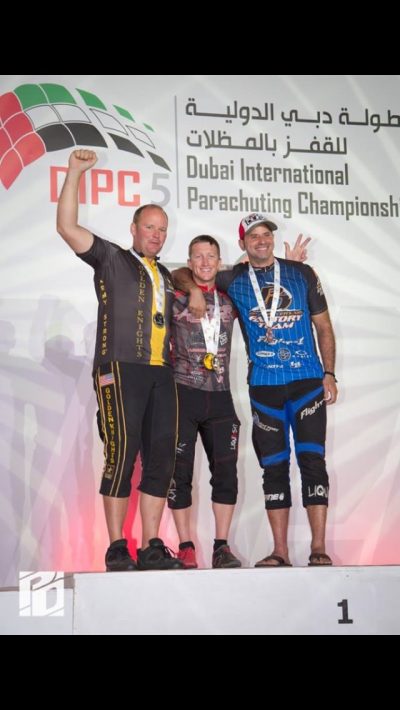
There’s no argument: AADs are complicated creatures. This is a piece of kit that requires teams of technicians, engineers, mathematicians, scientists and R&D testers to advance. Explaining them in a meaningful way is a task that causes many teachers to back slowly away. Greg, for one, does not retreat.
Skydivers are smart. Offer them all the information you have – share your wisdom!
“People need to know that stuff, especially when they’re advancing into faster parachutes,” he nods. “People need to know every single thing possible about their equipment and also if they’re getting to the point where they’re basically outgrowing — or outperforming — their equipment. You have to trust them to learn.”
“In the skydiving community,” he adds, “We take for granted that skydivers nowadays are a lot smarter than we were when we learned how to skydive. They have more equipment that’s going to make them safer. There’s more information to offer them, and we need to give them as much as they can take. The idea of ‘information overload’ is a lazy teacher’s excuse. They’re sponges. If you’re not giving them all the knowledge available because you’re telling yourself they won’t absorb it, then you’re doing them a disservice.”
As Greg views it, participating in the sport as a conduit for good information has been his key responsibility for nearly as long as he can remember.
“The vast majority of my skydiving career has all been dedicated to canopy; to learning about it and trying to figure out as much as humanly possible,” he smiles. “I’ve gotten a lot of great wisdom from a lot of great people. I humbly try my best to share that wisdom onwards.”
If everyone who has been gifted that wisdom and that knowledge would take it and pass it along, you’d be amazed at how efficient we’d be as a community. How safe we’d be,
he concludes, “We could finally identify the stuff that’s old-school and just kind of get away from it — and teach relevant stuff; the stuff that actually matters. I’m working towards making that a reality.”
——
CYPRES is proud to support Greg Windmiller as he makes an important contribution to a better understanding of the correct use of the CYPRES. If you want to reach out to Greg, see on facebook, his website or send him an e-mail.
* Fun fact: About four days before the 2014 US Nationals, Greg was carving through the speed course when his canopy caught one of the markers and slammed him into the ground. He broke his humerus and tore his rotator cuff. Four days later he competed in Nationals. He took third overall.
Tags: Golden Knights, Greg Windmiller, Superior Flight Solutions
Adventure, Tips, and Adrenaline
Subscribe to Our Newsletter
By signing up for our newsletter you declare to agree with our privacy policy.

